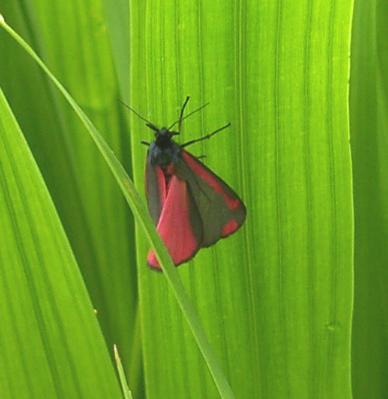Cinnabar Moth
Scientific name: Tyria jacobaeae

A Cinnabar Moth after landing with its bright red hind-wings partially exposed.
The Cinnabar Moth is quite common in the British Isles and flies at dawn and the early evening as well as at night. There is one generation per year, appearing from May to July. It usually rests during the middle of the day on low vegetation, but flutters off if disturbed, showing its bright colours which make it easy to spot. The red patches on its black fore-wings and the all red hind-wings give rise to the name - coming from the red mineral, cinnabar. The bright colour is also a warning to predators that it is one of the most poisonous insects around.
After mating the eggs are laid on Ragwort and related plants - but Ragwort is the main food source. The toxins in the leaves do not harm the caterpillars, but protect them, making them poisonous and unpleasent tasting. Other plants sometimes eaten are Groundsel and Coltsfoot. The caterpillars are also cannabalistic which is not always caused by a lack of food, although a large infestation can strip the plants of their foliage. They have bright yellow and black stripes running around their slightly hairy body and can reach about 30mm in length.
Although native to Europe and central Asia, it has been introduced to North America, Australia and New Zealand as a biological control for Ragwort.
Back to GARDEN CREATURES